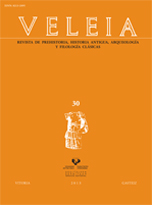Movilidad de personas y relaciones entre ciudades en época romana en el "conventus" de "Caesar Augusta": aspectos epigráficos y prosopográficos
##plugins.themes.bootstrap3.article.main##
##plugins.themes.bootstrap3.article.sidebar##
Resumen
Tradicionalmente —a través de las alusiones a la origo— la documentación epigráfica latina ha servido para trazar los posibles itinerarios que siguieron los movimientos de población en época romana y para, en función de las características de la documentación, profundizar en las razones de los mismos. Determinados territorios —como el conventus de la colonia Caesar Augusta (Zaragoza)— se presentan a este respecto especialmente atractivos no sólo por la variedad de menciones de origo que aporta el repertorio epigráfico procedente de sus comunidades sino, también, por la presencia que, de individuos con origo en aquéllas, puede seguirse fuera del propio conventus. El presente trabajo pretende profundizar en los parámetros en que puede fijarse esa movilidad geográfica de los ciudadanos de las comunidades de este conventus en todo el ámbito hispano atendiendo, también, a los casos en que dicha movilidad pudo estar amparada en relaciones políticas establecidas entre las comunidades o en que dichas relaciones intercomunitarias descansaron en lazos previos de carácter personal entre los miembros de sus elites rectoras.
Descargas
##plugins.themes.bootstrap3.article.details##
A no ser que se indique lo contrario, los contenidos de la edición electrónica de la plataforma OJS se regulan por una licencia de uso y distribución Creative Commons Atribución-NoComercial-SinDerivadas 4.0 Internacional (CC-BY-NC-ND).
La revista no cobra ninguna compensación económica a los autores por publicar en ella y da total acceso a los archivos sin ningún tipo de embargo desde el día de su publicación electrónica. Se respeta así la política nacional de acceso abierto.
Todos los originales publicados en la revista Veleia, ya sea en su formato impreso o en el digital, son propiedad de la Universidad del País Vasco (UPV/EHU). © UPV/EHU
Los autores de artículos (sean artículos de investigación, noticias, varia o reseñas) podrán acceder a sus propias obras en la página web de la revista. Los autores podrán colocarlos en sus repositorios personales y cuentan también con la posibilidad de difusión pre-print de los artículos ya admitidos para publicar.

